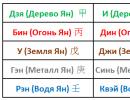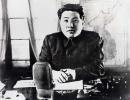Lexical topic "profession". Profession: mason. Who is a mason, description of the profession Why is it difficult to be a builder
Target test tasks:
· Objectively and impartially assess each student’s knowledge on the topic “Brickwork Technology”;
Task for the test taker:
“Choose the correct answer to the question from the options presented.”
1. What is the name of a structure made of bricks laid on mortar in a certain order?
A) masonry.
B) pyramid.
B) construction site.
D) wall.
2. What are the outermost rows of bricks or stones in a masonry row that form the surface of the masonry called?
A) forgettable.
B) miles.
3. What is the name of a row of bricks facing the outer surface of the wall with a long side edge?
A) backfiller.
B) tychkovy.
B) bed.
D) spoon.
4. What is the name of a row of bricks facing the outer surface of the wall with a short edge?
A) backfiller.
B) tychkovy.
B) bed.
D) spoon.
5. What are the names of the bricks and stones laid between the outer and inner versts?
A) forgettable.
B) mile.
B) bed.
6. What is the ability of masonry to maintain its position under loads called?
A) strength.
B) fortress.
B) stability.
D) balance.
7. What is the order of laying bricks (stones) relative to each other called?
A) dressing system.
B) order.
B) masonry.
D) stone structure.
8. What is the name of a steel blade, polished on both sides, with a wooden handle, which is intended for leveling mortar over masonry, filling vertical seams with mortar and trimming excess mortar in the seams?
A) mortar shovel.
B) mopping.
B) trowel.
D) jointing.
9. What is the name of the tool that is used to feed and spread the solution on the wall and mix it in the box?
A) mortar shovel.
B) trowel.
B) mopping.
D) jointing.
10. What is the name of the tool that is used to process seams, that is, to give them a certain shape?
A) order.
B) mopping.
B) trowel.
D) jointing.
11. What is the name of the tool that a mason uses when cutting whole bricks into partial ones and when hewing bricks?
A) hammer-pick.
B) trowel.
12. What is the name of a tool designed for cleaning ventilation and smoke ducts from mortar protruding from the seams, as well as for more completely filling the mortar and smoothing the seams in the ducts?
A) mop.
B) mopping.
B) trowel.
13. What is the name of a tool consisting of a steel cone-shaped body, a twisted cord and an aluminum strip, used to check the verticality of walls, piers, pillars and masonry corners?
A) rule.
B) level.
D) pier.
14. What tool is used to check the horizontal and verticality of masonry?
A) rule.
B) level.
D) template.
15. What is the name of a tool that is a planed wooden strip with a cross-section of 30x80 mm, 1.5...2 m long, or a special profile duralumin strip 1.2 m long, intended for checking the front surface of the masonry?
A) rule.
B) template
D) level.
16. What tool is used to check the squareness of laid corners?
A) rule.
B) level.
D) square.
17. What is the name of a twisted cord 3 mm thick, which is pulled when laying versts between rows and beacons as a guide to ensure the straightness and horizontality of the masonry rows?
A) order.
B) rule.
D) cord - mooring.
18. What is the name of a device made from angles, pipes or wooden slats with divisions marked on them, corresponding to the thickness of the horizontal rows of masonry (77 mm)?
A) order.
B) rule.
D) template.
19. What is the name of the section of the wall being built and the part of the area adjacent to it, within which materials, devices, tools are placed and the mason himself moves?
A) dressing system.
B) workplace.
B) materials zone.
D) construction zone.
20.What dressing system are used to lay the pillars and piers?
A) Single row;
B) Stepped;
B) Multi-row;
D) Three-row
21.What brick laying techniques does a bricklayer use?
A) "private"
B) “butt”
B) “snugged”
D) “half-squat”
22.What masonry dressing systems do you know?
A) Single row
B) Stepped
B) Multi-row
D) Three-row
23.The strength of which masonry dressing system is higher:
A) Single row.
B) Multi-row.
B) Three-row.
D) Double row.
24.The thickness of horizontal joints in masonry should be
25.Which of the following operations relates to the laying of walls:
A) Vacation;
B) Grinding;
B) Layout;
D) Nickel plating.
STANDARD ANSWERS:


CHILDREN SHOULD KNOW:
Names of different professions.
Purpose of different professions.
CHILDREN SHOULD KNOW NOUNS: doctor, builder, teacher, fireman, photographer, cook, hairdresser, policeman, tailor, shoemaker, baker, writer, pilot, driver, librarian, salesman, gardener, carpenter, painter, bricklayer, electrician, crane operator, excavator operator , welder, glazier, craftsman, architect, tractor driver, combine operator, milkmaid, poultry worker, pediatrician, dentist, ophthalmologist, surgeon, neurologist, nurse.
ADJECTIVES: kind, attentive, caring, responsible, professional, skillful, knowledgeable, conscientious, disciplined;
VERBS: treats, teaches, educates, stews, photographs, cooks, cooks, cuts, lays, looks after, sews, mends, cuts, bakes, writes, composes, flies, drives, carries, gives out, receives, sells, counts, cares, grows, lays, installs, lifts, manages, paints, digs, plans, glass, welds, sows, plants, digs.
ONE IS MANY.
Teacher - teachers - teachers.
Doctor - doctors - doctors.
Seller - sellers - sellers.
Baker - bakers - bakers.
Photographer - photographers - photographers.
Tailor - tailors - tailors.
Milkmaid - milkmaids - milkmaids.
Postman - postmen - postmen.
NAME BY MODEL (children over 6 years old):
He is an artist and she is an artist.
He is a teacher and she is... .
He is a writer, and she is... .
He is a guide, and she is... .
He is a singer and she is... .
He is a translator, and she is... .
WHO DOES WHAT?
Teacher - teaches reading, writing, counting.
A fireman puts out a fire.
Builder - builds and repairs houses.
Painter-plasterer - paints, whitewashes, plasters.
Photographer - takes photographs.
Cook - ... .
Tailor - ... .
Hairdresser - ... .
Librarian - ... .
Doctor - ... .
Writer - ... .
Driver - ... .
Tractor driver - ... .
Milkmaid - ... .
Poultry - ... .
WHO NEEDS WHAT FOR WORK?
Hairdresser - scissors, comb, hair dryer, curlers.
To the doctor - medicine, a white coat, a thermometer.
To the artist - ... .
To the teacher - ... .
To the tailor - ... .
Painter - ... .
Rybolov - ... .
To the seller -... .
To the gardener - ... .
To the carpenter - ... .
Milkmaid - ... .
To the tractor driver - ... .
GUESS THE PROFESSION (children over 6 years old).
Who carries the luggage? (Porter.)
Who welds the pipes? (Welder.)
Who installs the glass? (Glazier.)
Who works on the crane? (Crane operator.)
Who lays the bricks? (Mason.)
Who sharpens knives? (Grinder.)
Who repairs the clock? (Watchmaker.)
Who works on an excavator? (Excavator operator.)
Who paints the walls? (Painter.)
Who takes care of the birds? (Birdwoman).
Who composes the music? (Composer.)
Who plays the piano? (Pianist.)
CONFUSION.
A painter sews clothes.
The driver controls the plane.
The hairdresser knits a sweater.
The librarian delivers mail.
The photographer composes music.
A tractor driver sews clothes.
DESCRIBE YOUR PROFESSION ACCORDING TO YOUR PLAN:
Name of profession.
What tools are needed to work in this profession.
What does a person in this profession do?
NAME (children over 6 years old):
Children's doctor - ... (pediatrician).
Dentist - ... (dentist).
Eye doctor - ... (ophthalmologist).
The doctor who performs the operation is ... (surgeon).
The doctor who treats nerves is ... (neurologist).
Physician assistant - ... (nurse).
Medical clothing - ... (cap, headscarf, gown, gloves).
Medical instruments - ... (syringe, spatula, pipette, thermometer, hammer, tweezers).
What is a profession? (Business, work, occupation.)
Name your parents' professions.
What are professions for?
What do you want to be when you grow up?
Why do you need to study professions? Where are they taught?
We get up very early, because our concern is
Drive everyone to work in the morning. (Driver.)
Will guide the glass eye,
Click once - and we remember you. (Photographer.)
We must fight fire -
We are partners with water.
They won't be afraid with us
Carbon gases are bad for you.
People really need us,
So who are we? - ... (Firemen).
Tell me who is so delicious
Prepares cabbage soup,
Smelling cutlets, salads, vinaigrettes,
All breakfasts, lunches? (Cook.)
SAY A WORD.
In the carpenter's bag you will find a hammer and a sharp... (knife).
Any tool is available - a plane, and... (a chisel).
We must fight fire.
We are brave workers.
We are partners with water.
People really need us.
So who are we? - ... (firemen).
I would be a pilot pilot
I definitely wanted to become
I was on a plane then
I would have reached Moscow... (Flew).
The hasty thread runs after the needle
I can do anything for myself... (sew).
It's not hard for me to mend a sock myself
Fix the pocket, sew it down... (belt).
There are probably a thousand pounds in it!
Heavy... (threshing).
I'm not bragging, I'll say:
I will make all my friends younger!
Despondent people come to me -
With wrinkles, with folds.
They are leaving very nice -
Fun and smooth.
So I'm a reliable friend
Electric... (iron).
In the world of diverse words,
What shines, burns and burns
Gold, steel. Diamond
There is no more sacred word... (labor).
The pilot lifts into the blue sky... (plane).
He drove the goats out onto the mound, cheerful... (shepherd boy).
Plane in hand - another job:
Knots, squiggles with a plane... (planing).
But our painter does not come into the house with a brush and a bucket:
Instead of a brush, he brought a mechanical... (pump).
So that people don't get wet in the rain
The roofer covers... (the house) with iron.
A crane is moving - a huge height
Delivers iron... (sheets) to the roof.
White sawdust is flying, flying from under the saw:
This carpenter makes frames and... (floors).
Should we buy bread or give us a gift -
You and I take the bag and go outside.
We walk along the shop windows and go into... (shop).
Well, in this store there is a pretzel, buns on the display,
Medicinal bread with bran. The store is called... (bread store).
Every day a newspaper is brought to our house... (the postman).
Seven brave young mowers were sharpening their scythes and cutting the grass... (mowed).
The roof is being painted in front of the children... (painters).
We are taking the boards up the mountain, we will build a new one... (house)
I fly dolls in the morning. Today I... (nurse).
It's time to paint the rooms. They invited... (painter). Baruzdin S.
The circus performer knows how to prance, animals and birds... (train).
Ir-ir-ir-my dad... (commander).
The future cabin boy brought us some southern fish... (sailor).
She didn’t drink or sleep, she gnawed on a tree... (saw).
The sharp-nosed one sews, stitches and pricks... (needle).

Lesson script
Technology 8th grade
Chapter:"Professional self-determination."
Subject: Professions and specialties of the construction industry.
Lesson form: debate + game
Purpose of the lesson: 1. Introduce students to professions and specialties in the construction industry.
2. Give an idea of the professionally important qualities of construction professions and specialties.
3. Prepare children for the right choice of profession and educational profile
Literature used: 1. Textbook "Technology" 8th grade for
educational institutions V.D. Simonenko. Moscow,
Ventanagraf Publishing House, 2009
2. Technology. Materials for the lessons of the section
“Professional self-determination” according to the program
V.D. Simonenko, A.N., Bobrovskaya. Volgograd, publishing house
"Teacher", 2007
3. Psychological analysis and professional profiles.
99 popular professions. E.S. Romanova. Saint Petersburg,
publishing house "Peter", 2006
4. Where to go to study? Directory of institutions
vocational education Kemerovo region
2009-2010 academic year. M.S. Bortnikova, K.R. Zhuravleva.
Kemerovo, 2009
Equipment: computer, projector, computer presentation “Architecture and Construction”
And " Educational institutions professional education in the construction industry"
posters “Man is famous for his work”, “A worker is the one who creates everything in the world”,
crossword on the board.
PROGRESS OF THE LESSON
- Organizational moment
Check students' attendance and readiness for class
2. New material
Teacher: Before I tell you what professions we will talk about today, I want to ask you a riddle.
Lays brick by brick -
Growing floor by floor,
And every hour, every day
Higher and higher is the new house.
Students: They answer that he is a builder.
Teacher: That’s right, today our lesson will focus on builders. Construction professions are in great demand in our region and city. And we’re not just talking about blue-collar jobs; specialists in construction are also needed.
And what construction professions You know?
Students: painter
plasterer
plumber
electrician
mason
Teacher: Well done guys, but that’s not all and adds:
roofer
tiler
crane operator
excavator operator
bulldozer
architect
Teacher: Let's do it now small excursion in the history of architecture and construction.
(Presentation 1)
Teacher:. So, the architect gets to work first on building a house.
Student 1 An architect builds a house
The house is multi-storey.
Builds a house with a pencil
On a piece of paper.
You need to draw everything
Calculate, check,
Stairs and doors.
May it stand for many years
So that there is light in the apartment,
Baths, washbasins
For big and small.
Teacher: When the building design and all documentation are ready, they begin to prepare the construction site. The first to arrive at the construction site is a bulldozer. What kind of work does he do? Levels the surface of the site.
The full lesson can be downloaded at the beginning of the page
Reproduction of materials on other sites is possible only by using a hyperlink to this page or to the main page of the site
Construction is one of the seemingly eternal professions. But there are many nuances that you need to know in order to succeed in it.
A construction worker and a migrant worker are not the same thing
Many people make the mistake of thinking that a builder is the one who lays the bricks. In fact, builders are conventionally divided into two groups: construction workers (the “hands” of construction) and engineering workers (the “brains” of construction). Because a builder is not even a profession, but a collective concept.
"Hands" of construction
Let's be honest: not everyone wants to work in an office. There are and have been professions created for those who respect working with their hands: masons, roofers, assemblers, painters, electric and gas welders... If these people weren’t there, today we wouldn’t live in new buildings, wouldn’t drive on new highways, wouldn’t walk on modern ones entertainment centers.
A mason lays a foundation and builds walls from blocks or bricks. Must know the properties of mortars, masonry systems, requirements for masonry quality, types of parts and prefabricated structures.
The roofer covers and repairs roofs, produces hydro-, heat- and vapor barriers, and prepares materials for sealing joints and seams.
The installer sets up wiring and lighting, installs electric motors, transformers and other equipment, runs overhead lines and lays cables in the ground.
The painter provides appearance finished structures. Must know technologies and methods for painting various types of surfaces with pre-applied insulating and/or waterproofing coatings, chemical composition paints and rules for choosing colors, technical specifications for finishing and drying products.
An electric gas welder welds parts, components, structures and pipelines made of structural steel, cast iron, non-ferrous metals; cleans and prepares for painting.
The foreman does the same as the workers, but is still responsible for the overall work.
To master one of these professions, studying at a vocational school is enough. All listed specialties have 5 categories (from 2nd to 6th). Vocational school graduates are assigned the 3rd or 4th category. It makes sense to increase it - the rank affects the salary. This can be done while working.
It is also easy to retrain at a construction site - working in a team, you can actually gain experience from your colleagues and master an additional specialty.
A career in construction can be built in this direction: become a foreman, then a foreman.
"Brain" of construction
Civil Engineer receives higher education in the basic construction specialty PGS (industrial and civil construction).
There are divisions within the profession: designers, estimators, production workers, designers, electricians, chief engineers, etc.
An engineer must know building codes and regulations (SNiP), estimate and design documentation, GOSTs. Must have independent drafting and blueprint reading skills. Proficient in special programs such as Avtocad, GrandSmet. Many employers as necessary condition indicate an indispensable knowledge of technical English.
With a diploma in civil engineering, you can go to work on a construction site or in a technical production department (preproduction engineer, quality engineer, cost estimate engineer).
If an engineer chooses to work on a construction site, his career may begin as a foreman.
The foreman organizes work at a construction site. He explains tasks to workers and monitors their implementation. Provides safe working conditions. Orders materials, calculates the number of employees, determines compliance with the project, maintains documentation.
Further, an engineer's career can develop to the head of a department or project, chief engineer, deputy or director of a construction company.
Construction industry salary overview*
Specialty Average salary (RUB)
Construction industry salary overview*
|
Speciality |
Average salary (RUB) |
||
|
Moscow |
Moscow region |
Kazan |
|
|
mason |
|||
|
installer |
|||
|
roofer |
|||
|
electric and gas welder |
|||
|
foreman |
|||
|
designer |
|||
|
constructor |
|||
|
electrician |
|||
|
chief engineer |
|||
*According to data worka.yandex.ru
Why is it difficult to be a builder??If we talk about working specialties in construction, this is, of course, hard work. You need to carry construction materials and work in any weather. The work is dusty in the literal sense of the word: you have to breathe dust and harmful substances. Accidents are not uncommon at construction sites.
If we talk about engineers, the difficulty here lies in the high responsibility that falls on their shoulders.
But not so long ago the profession was honorable. Was especially respected in post-war years. What seems so familiar to us today - high-rise buildings, shops, factories - was just beginning to be built en masse then.
In the 2000s, people went into construction for the money. A man with "hands", even having primary education, could receive a very decent salary and earn extra money if desired.
But after the 2008 crisis, a lot has changed. The profession's ratings have fallen sharply, as have salaries. Employers cut back where they could cut, many were fired, and many crews left on their own.
Who said that our people don’t want to work?
Back in the 1990s and 2000s, there were no migrants from the southern republics at construction sites former USSR. Russians worked, and the work was not considered “dirty.” It was possible to get an apartment after serving the required amount.
Now some people have the impression that Russians do not want to work in construction, in housing and communal services, etc., so migrants work there. In fact, this is a double-edged sword: developers are chasing excess profits, using cheap labor - people who can be underpaid and kept in unimaginable living conditions. Migrant workers agree to this, Russians do not.
The situation would be resolved in favor of “ours” if the market were regulated by the state, as it operates, say, in the USA and Great Britain: minimum wages are established there, but not in Russia.
But still, one cannot say that Russians do not want to work. Yes, it is possible that a Muscovite who has received a higher education will not choose a working specialty in construction, because he does not want to work for that kind of money. But residents of the Moscow region and regions are ready to take on this work. And there is a demand for them - there is always a shortage of qualified personnel at construction sites.
“In the regions, a salary of 30,000-40,000 rubles is above average. So they go to Moscow to work. Work - on a rotational basis: 2 weeks there, 2 weeks at home. There is no point in moving permanently and even with your family - life in Moscow will be worse due to the lack of your own housing.”
Yuri, 55 years old
According to statistics from the website rjob.ru for 2012, the most in-demand construction specialties are installers. Electricians are in 2nd place, and designers are in 3rd place.
A construction worker and a migrant worker are not the same thing
Many people make the mistake of thinking that a builder is someone who lays bricks. In fact, builders are conventionally divided into two groups: construction workers (the “hands” of construction) and engineering workers (the “brains” of construction). Because a builder is not even a profession, but a collective concept.
"Hands" of construction
Let's be honest: not everyone wants to work in an office. There are and have been professions created for those who respect working with their hands: masons, roofers, assemblers, painters, electric and gas welders... If these people weren’t there, today we wouldn’t live in new buildings, wouldn’t drive on new highways, wouldn’t walk on modern ones entertainment centers.
Mason lays the foundation, builds walls from blocks or bricks. Must know the properties of mortars, masonry systems, requirements for masonry quality, types of parts and prefabricated structures.
Roofer covers and repairs roofs, produces hydro-, heat- and vapor barriers, prepares materials for sealing joints and seams.
Installer sets up wiring and lighting, installs electric motors, transformers and other equipment, installs overhead lines and lays cables in the ground.
Painter provides the appearance of finished structures. Must know technologies and methods for painting various types of surfaces with pre-applied insulating and/or waterproofing coatings, the chemical composition of paints and rules for selecting colors, technical conditions for finishing and drying products.
Electric and gas welder welds parts, components, structures and pipelines made of structural steel, cast iron, non-ferrous metals; cleans and prepares for painting.
Brigadier does the same thing as workers, but is also responsible for general labor.
To master one of these professions, studying at a vocational school is enough. For example, in Vocational School No. 72, Vocational School No. 69 or Vocational School No. 40.
All listed specialties have 5 categories (from 2nd to 6th). Vocational school graduates are assigned the 3rd or 4th category. It makes sense to increase it - the rank affects the salary. This can be done while working.
It is also easy to retrain at a construction site - working in a team, you can really gain experience from your colleagues and master an additional specialty.
A career in construction can be built in this direction: become a foreman, then a foreman.
"Brain" of construction
A civil engineer receives a higher education in the basic construction specialty of PGS (industrial and civil construction). For example, at the Military Technical University under the Federal Agency for Special Construction or at the Moscow State Academy of Utilities and Construction (has branches in 5 cities in the region).
There are divisions within the profession: designers, estimators, production workers, designers, electricians, chief engineers, etc.
An engineer must know building codes and regulations (SNiP), estimate and design documentation, GOSTs. Must have independent drafting and blueprint reading skills. Proficient in special programs such as Avtocad, GrandSmet. Many employers specify knowledge of technical English as a prerequisite.
With a diploma in civil engineering, you can go to work on a construction site or in a technical production department (preproduction engineer, quality engineer, cost estimate engineer).
If an engineer chooses to work on a construction site, his career may begin as a foreman.
The foreman organizes work at a construction site. He explains tasks to workers and monitors their implementation. Provides safe working conditions. Orders materials, calculates the number of employees, determines compliance with the project, maintains documentation.

Why is it difficult to be a builder?
If we talk about working specialties in construction, this is, of course, hard work. You need to carry construction materials and work in any weather. The work is dusty in the literal sense of the word: you have to breathe dust and harmful substances. Accidents are not uncommon at construction sites.
If we talk about engineers, the difficulty here lies in the high responsibility that falls on their shoulders.
But not so long ago the profession was honorable. She enjoyed special respect in the post-war years. What seems so familiar to us today - high-rise buildings, shops, factories - was just beginning to be built en masse then.
In the 2000s, people went into construction for the money. A person with “hands”, even with a primary education, could receive a very decent salary and earn extra money if desired.
But after the 2008 crisis, a lot has changed. The profession's ratings have fallen sharply, as have salaries. Employers cut back where they could cut, many were fired, and many crews left on their own.






